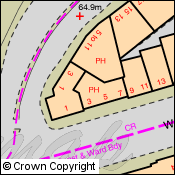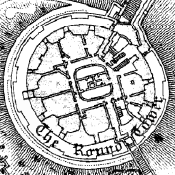There is a very good article on the GoGeo blog about making campus maps using the Digimap Roam service’s annotation tools:
Making simple campus maps using Digimap Roam

Digimap is an online map and data delivery service, available by subscription to UK Higher and Further Education establishments. Operated by EDINA at the University of Edinburgh, Digimap offers a number of data collections, including Ordnance Survey, historical, geological, aerial photography, LiDAR, marine maps, land cover mapping, global mapping and census data. For more information about Digimap go to our website: https://digimap.edina.ac.uk Background image Contains OS data (c) Crown Copyright and database right 2022
There is a very good article on the GoGeo blog about making campus maps using the Digimap Roam service’s annotation tools:
Making simple campus maps using Digimap Roam

As lots of people are currently working on projects and dissertations we thought we’d share a few tips on using the OS MasterMap data from Digimap.
 NOTE: MasterMap Download will be temporarily unavailable as part of the ‘At Risk’ period on Monday the 22nd of August. It will also be unavailable for about an hour on either Wednesday 24th or Thursday the 25th of August as well. This is to allow for some essential hardware maintenance on the server that houses the Database. We are really sorry for any inconvenience this causes.
NOTE: MasterMap Download will be temporarily unavailable as part of the ‘At Risk’ period on Monday the 22nd of August. It will also be unavailable for about an hour on either Wednesday 24th or Thursday the 25th of August as well. This is to allow for some essential hardware maintenance on the server that houses the Database. We are really sorry for any inconvenience this causes.
The MasterMap data available will be updated as part of our annual data refresh at the beginning of September. If you need the 2010-2011s data then please order in advance of Monday the 22nd to ensure you don’t get caught up with the maintenance.
Remember that if you just want MasterMap as a background map you can use the 1:1000 or 1:2000 Raster versions of the data. This is available from the Data Download facility:
If you need the vector data for use in a GIS then you will need MasterMap Download:
There is also a video on using MasterMap Download:
[youtube width=”640″ height=”390″]http://www.youtube.com/watch?v=-G7mEYX4ikE&hd=1[/youtube]
Once you have downloaded your MasterMap Data you will most likely need to convert it into a format that your GIS can use. There are three main options to do this, InterpOSe, OSM2MIF and Productivity Suite, see the following link for more information:
Getting MasterMap into a GIS or CAD
Using MapManager / Productivity Suite to convert MasterMap
Using MasterMap Data with AutoCAD:
[youtube width=”640″ height=”390″]http://www.youtube.com/watch?v=52UfIezk25M&hd=1[/youtube]
This year’s annual data update will take place at the beginning of September. There will be a refresh the following Ordnance Survey products:
There will also be updated Hydrospatial data in Marine Digimap and a new version of the DiGMapGB-50 data in Geology Digimap.
Along with the new data Ancient Roam will be getting the Annotation Tools and there may be a bit of a surprise bonus addition to Digimap Roam. More information will be posted on the Blog, Twitter and Facebook page nearer the time.
Now we have the annotation tools up and running they are being added to all the Roam services thick and fast! Marine Roam is the latest to get the tools, again they are an initial version with the basic set of features.
Please let us know if you have any requests for symbols, line styles or any other features you would like to be able to annotate the map with. You can comment on this post or email us directly here:
Remember there is a video on how to use the general features of the Annotation tools on YouTube:
[youtube width=”640″ height=”390″]http://www.youtube.com/watch?v=PSkTZvMNyKU&hd=1[/youtube]
There is also a section in the How to use Marine Roam help page that covers how to use all the different tools:
Following on from the success of the annotation tools in Digimap Roam, we have now added them to Geology Roam. The tools are the same as the one in Digimap Roam at the moment but we hope to add in a set of geology specific symbols and features in the near future.
We’d like to know what sort of annotations you’d like to put on the geology maps; perhaps a dip and strike symbol you can rotate and add a dip value to, or a borehole symbol that you can label with a depth and ID number. Please comment on this article if you have any ideas or send us an email:
Don’t forget we have a quick guide on what you can do with the annotation tools on YouTube:
[youtube width=”640″ height=”390″]http://www.youtube.com/watch?v=PSkTZvMNyKU&hd=1[/youtube]
We also have a section in the Geology Roam help page that describes how each of the different tools works:
We hope to add the annotation tools to the remaining services over the summer, keep checking the blog for news of when they will be released.
You can now download high quality PDF maps from Ancient Roam for printing. This element of the service has been quite tricky to implement, so until now we have only had the save image button ![]() to get a PNG image of the map you are viewing.
to get a PNG image of the map you are viewing.
Now you can use the print button ![]() to access a similar interface to the ones found in all the other Roam services. You can see a sample PDF by clicking on the thumbnail below:
to access a similar interface to the ones found in all the other Roam services. You can see a sample PDF by clicking on the thumbnail below:

There are still a couple of options to add into Ancient Roam print maps; we need to add the ability to print 2up maps and the ability to switch off counties in areas where there are overlapping maps. Look out for these arriving in the near future.
Information about how to use all the features of Ancient Roam can be found on the following help page:
The VectorMap Local (VML) maps mentioned in the previous blog posts are now working in Digimap Roam. There is a video on YouTube showing you how to view all the different mapping styles that are now available at the four most zoomed in levels; including all the VML maps and Land-Line style MasterMap:
[youtube]http://www.youtube.com/watch?v=wadgUWe3jNA[/youtube]
For more informations see the previous blog post here:
More Improvements Coming Soon, June 20th 2011
 Some of the features mentioned in the previous blog post will be added into the services tomorrow, Tuesday 28th June:
Some of the features mentioned in the previous blog post will be added into the services tomorrow, Tuesday 28th June:
Due to this work there will be some short Disruptions to all the services between 17:30 and 18:30. We hope you find the new features useful, please let us know if you have any feedback:
or call us on: 0131 650 3302
We have had another very busy month and so a new batch of improvements for the Digimap services will be coming soon.
At the moment downloading data or saving screen images are the only ways to use the maps available in Historic Digimap once you have logged out. Soon you will be able to create and save high quality PDF maps from Ancient Roam for use offline. We hope you will find this a much better way to get the best quality mapping out of the service.

Since the arrival of the Ordnance Survey’s latest large scale product, VectorMap Local, we have been busy thinking of the best way to include it in the Digimap Roam. We have decided to use it to create four new representations available at two different scale levels.
Here is a quick look at what the four different representations might look like:




We haven’t stopped there either; we are also going to add in Line Drawing style mapping to the two most zoomed in levels; for those who like their MasterMap plain and simple, similar to planning application maps.

You will be able to select the different views from the Map Content Control Tab using a drop down list.
For more information about VectorMap Local look in the Digimap help pages as it is already available for download:
OS Products: OS VectorMap Local
For those of you who have tried the annotation tools in Digimap Roam it will come as no surprise that we are very pleased to announce that we are now working on adding the same functionality in Geology Roam. Again the annotation tools are a first draft and will have exactly the same functionality as Digimap Roam’s tools.
Once they are released we’d really like to hear from you about which functions you use and what else you would like added. We are already hoping to add in some Geology Mapping symbols for you to add to the maps.
As an added bonus we are also putting in the measurement tools so you can measure areas and distances too, so you can tell how long a fault is or what area is covered by different rock types.
![]() All our YouTube videos are now available under the Creative Commons licence. This means that you can copy, distribute and create derivative works from them if you give us credit. The videos are now available in the YouTube video editor so you can use them to help other users or show people what you have learned to do.
All our YouTube videos are now available under the Creative Commons licence. This means that you can copy, distribute and create derivative works from them if you give us credit. The videos are now available in the YouTube video editor so you can use them to help other users or show people what you have learned to do.
For information on what the Creative Commons licence means and how to edit the videos within YouTube go to this web page:
We’d really like to hear from you if you have been using our videos; please send us an email: edina@ed.ac.uk
If you have an idea for a video you’d like us to make you can join the discussion on our Facebook page: Facebook | YouTube Discussion